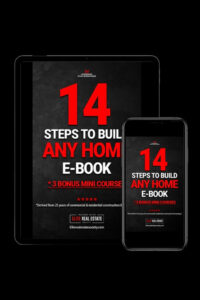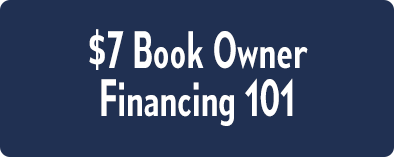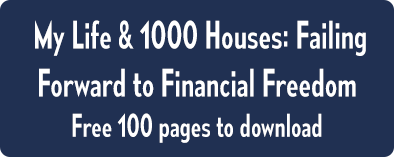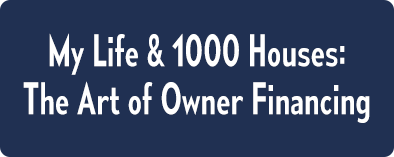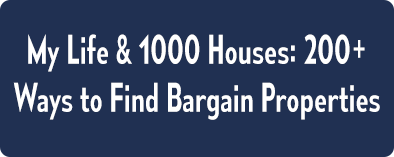PODCAST
How To Build On Land With Jerome Maldonado
Episode 531: How To Build On Land With Jerome Maldonado
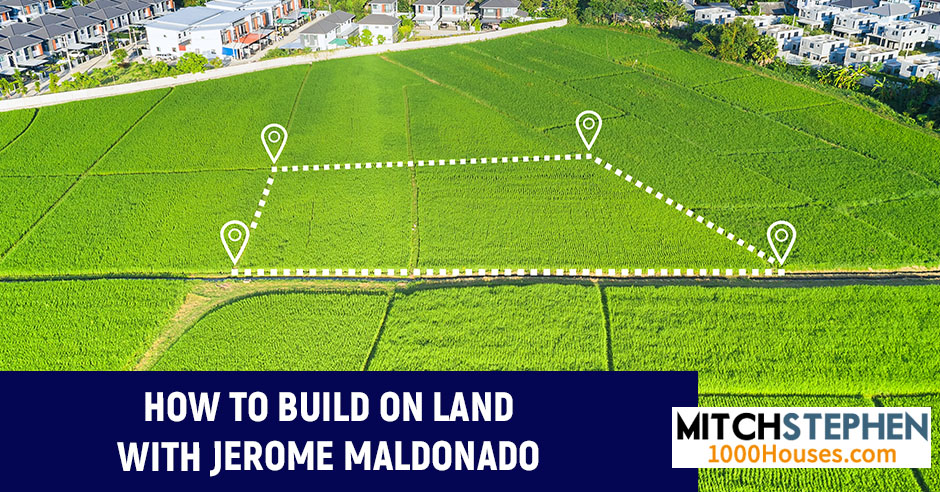
How do you build on land and diversify your passive income? Mitch Stephen welcomes Jerome Maldonado, who created an eight-figure empire in his real estate business. Jerome shares how he buys land and builds a house on it, making a hundred grand each time. Repeating the process held them together during the recession. The strategy is to build affordable housing models in the apartment sector. If you can’t traditionally sell your property, you can lease it or owner-finance it. Do you want more tips on how to build on land? Tune in!
—
Watch the episode here
I’m here with Jerome Maldonado. He’s over in Albuquerque, New Mexico but he’s from San Antonio. He has got a unique concept. I have not talked a lot about this on my show. It’s how to buy land and build on it. That has a big connotation because it’s not just buying a lot and building a house. You can buy land and build anything. You can build apartment complexes, strip centers, whatever. We are going to be talking to Jerome about that. Jerome, how are you doing?
I’m good. How are you? I lived in San Antonio for a very long time, so I have love and heart space for it.
I always envied the people that started early. You started early. In your early twenties, you were out there swinging for the fence. You fell victim to some of the things that people who start being very successful at a young age fall victim to. You feel like it’s never going to end, and then one day it does, and then everybody learns their lessons. Tell us a little bit about your beginnings, peaks and valleys, and where you are now.
Im a young entrepreneur from the heart in nature. I matured into the real estate industry in the late ’90s as a very novice investor, and then into the 2000s, I started gaining some information, knowledge, and wisdom. Through and through, thick and thin, I’m an old-school business and sales guy. I consider myself an entrepreneur and business person than a real estate person because I’ve got started in direct sales and network marketing while I was in college. I was living the dream. It was the storybook tale that our parents and everybody else taught us where we have to go to school and get a good education.
At the beginning of my fourth year in college, I found direct sales and network marketing. I sucked at it. I was horrible at it. For two and a half years, I was dead awful at it. I finally figured it out and learned how to hit the nail on the head and became a top distributor in that company. Lo and behold, we were published. It got a lot of publicity in 1995 and 1996, and all that publicity led to the FTC investigating and nitpicking how we did business and shut us down in 1997, along with a lot of other companies.
If the asset is a lot of work and the return on investment is small, get rid of it. Share on XIt left me, a young kid, making a ton of money in my twenties. We were doing about $25,000 net a month. I was buying cars, houses, and traveling the world, and it went to zero overnight. We found ourselves a victim of having nothing because we spent everything and had no assets. My story unfolds from there. I came home and finished my last year of college, and that’s when I’ve got into construction. When I was in college, I never thought I would be in some construction. Through the means of default, I landed with construction. It has become a very lucrative business, leading me to where I’m at now.
You said a lot right there but let’s back up to that part. If you are a young man in your early twenties or late teens and starting to have some success or flipping some houses, please pay attention. I was telling Jerome that it’s almost in everybody’s story who hit big success young. It’s almost inevitable that it’s going to end with the same thing like, “I went out and bought ars, Rolex watches, and then I went broke.”
If you are younger, pay attention. At the end of that little travesty, he said, “We didn’t buy assets,” meaning he bought toys. When the rollercoaster ride went over, the toys didn’t produce any money. In fact, they cost you money generally. If you want to be a smart guy and exceed your age with your actions, buy assets and things that make more than they cost every month when you are rolling in the dough because when it all goes to shit, the water spigot turns off, and the money doesn’t come anymore. You’ve got these assets to show for it that should pull their own weight, plus put money in your pocket. That’s the point I wanted to make before we go much further because I hear that story all the time.
I didn’t have that story but I could have. I’ve never got that successful when I was young. I wasn’t allowed to make that mistake because I never made any money. In my whole career, I never had any real windfalls. I was making more this 2022 than 2021 by a little bit, and I kept going. It was a blessing in disguise because I’ve never got rich beyond my comprehension. I knew what it took to make every dollar and valued it because I had to crawl on my hands and knees over every peak. I’m not saying it’s the best way but that’s how my way went.
You started a construction company and then started taking control of your inventory. This is why I like the way the entrepreneur thinks. He starts taking control of his downtime by buying land and building on it during the times when it is slow like November, December, and January. You said that’s when you could get a lot done. Were you working on your own projects during those months?
What happened is I land up getting my contractor’s license in 1998 in lieu of helping my brother-in-law. I didn’t know anything about construction. I used to labor for those guys in my early years of college, sanding drywall. I started bidding on metal stud framing and drywall projects. I found out there was money in decorative concrete, specifically.
For those of you who walked into rainforest cafes and saw all that beautiful, decorative concrete work or back before they renovated New York, New York used to be a ton of that stuff. In fact, that’s where I took seminars in Las Vegas. I was building out decorative concrete and bidding this stuff on golf courses all over the country. What happened was in the winter times, I started buying assets because of what we talked about. I bought single-family rental homes. I wanted something to show for my money. I started making good money again.
Was there anything fancy?
They were just little homes. In fact, they were junk and older homes. They were probably built in the ’60s or ’70s. It had some problems like warped-out floors and big trees that were overgrown. The properties needed work. We picked them up, chopped out a lot of bamboos, and this, that, and the other. We made them look pretty and rented them. I was forced to buy a construction yard.

Build On Land: It was a humbling beginning of exercising practical knowledge and gaining direct sales from running training centers.
When we were in network marketing, we rented sales training centers. Distributors would rent desk space from us in the ’90s. This is where I learned a little bit about real estate, not knowing I was learning about real estate. It was a humbling beginning, and I exercised the practical knowledge that I gained in direct sales from running training centers. I wasn’t smart enough to figure out the network marketing game back in those days but I was smart enough to figure out that if I could put some butts in chairs and charge them $500 for desk rent, I could pay my rent on the building.
I did that in direct sales before I had success, and then I utilized that same concept with my construction company. We were forced to get a building, so I bought a retail center with the mindset that I would get other people to pay for the building for me. I thought, “Let me buy something bigger than I need. I will rent out the space. I will charge them rent, and will be mortgage-free.” That’s what I did.
It was a stupid, simple concept. I didn’t know anything about real estate, and that’s how I bought my first retail center. It worked so well. I remember my dad coming down, looking and going, “What happens if it doesn’t rent?” Being the optimist I am, I said, “I never thought about that. It’s going to rent.” I knew how to sell. I was going to get somebody to rent that place from me. If I could get people to buy water filters and sell them desk space back in the day and age when there was only bottled water on the shelves for radiators and Evian, I could get some people to lease a nicely remodeled building from me, so I did. The next year, I bought another one.
You hit the nail on the head when you said, “I utilized this to keep my crews busy.” In the winter months, being in the Southwest, we get a lot of snow. To keep my crews busy in the wintertime, I buy a building every year for sixteen years, and I would renovate it to either keep it or sell it in the spring. I use those buildings to make money. In 2004, I started buying land and building retail centers and new construction. We went through the whole process along the line. That’s what’s helped us evolve into what we are doing now.
In all cases, I have had three buildings in my life because I don’t specialize in commercial buildings. I had 2 at 1 time, and then I said to myself, “You’ve either got to get twenty of these things or get out of business,” because you’ve got to have the economy of scale. You have to pick a business, and then get up way off the ground with it.
To protect yourself from unforeseen circumstances, build affordable housing models in the apartment sector. Share on XI had such a good house flipping business and some other businesses that were already doing well that I thought, “This is not my cup of tea.” I’m building an office. We needed about 3,500 square feet. We went ahead and bought a building that we needed to remodel. It’s about 6,000 square feet, and we are doing exactly the same thing. We are renting out 1/2 of it. We designed it that way. We are going to have the one half, and then the other one, we are going to lease.
We leased it out and got paid $3,000 a month to have our own office space and rent out the other side. I love that concept. You don’t need to pay for the building yourself. If you think one step ahead, get some extra space and lease it out, and at least try to zero out or cut your space down to where you are hardly paying anything for it because you are charging for the other half of your building.
You have construction companies, and then the construction companies have to run to get work all the time. In the winter months, it might slow down depending on where you live because of the snow and the rain. It’s hard to control. It’s the idea of buying or developing your own property. Always have one of your own properties on the side to develop, so if your crew is slow, they are still going to work. They are just going to work back on that job, the one that’s for me. That’s brilliant because your crews never sit on their ass, and you never run out of time. There are probably some tax moves to be made in there somewhere.
There sure is, especially on all the commercial stuff. I have been a little bit more hyper-ambitious than most people. I have been driven by hard work my whole life by my parents and everything growing up, from running a lot of land, animals, and other stuff as a kid. It was one thing that led to another. We went in working for other people, found the means that I could buy a piece of land, build a house, make $100,000 every time I built a house, and it did so. That held us together during the recession. When no one else was calling, we figured out a business model. Houses were still selling. They were just selling differently. You guys don’t know. You are in San Antonio.
Red McCombs was still scraping land up in San Antonio and building houses during the recession. He didn’t even know there was a recession. The diversification of what we were doing was not something that I thought was going to be our saving grace by any stretch of the imagination. I did it to scale, make more money, and evolve my businesses.
I held onto everything that worked, so we opened up coffee shops and beauty salons. We were one of the largest subway franchisees in the Southwest at one point in time, and everything that I didn’t like that didn’t make us the ROI that I loved, I’ve got rid of. If it was a lot of work and the return on investment was small, I’ve got rid of it. If it was a lot of work but it made us a good return, I kept it.
As we evolved into a lot of uncharted territory moving into the recession, a lot of our diversification, lo and behold, is what held us together. As crazy as it seems, when the biggest housing market crisis was happening, it was our single-family dwellings that we were building that kept us together. We just had to reposition our business model, and we continued profiting. We sold the homes for less money and took a small margin cut but continued moving forward.
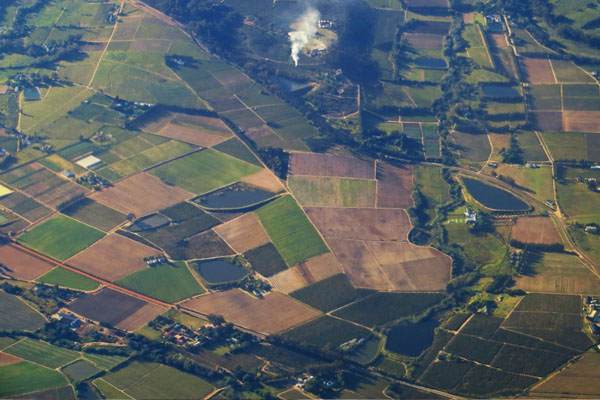
Build On Land: Buying a piece of land, building a house, and making a hundred grand each time held us together during the recession.
You have kept your crews busy and moving. It’s hard to put good crews together. I’m rehabbing four houses every day of my life. You’ve got to keep those guys busy or they go away. When you have a good one, you need to keep them. You have a giveaway. You are giving away a book on fourteen steps on how to buy land and build a house but it doesn’t have to be a house. It’s on how to buy land and build.
I did this, too. I was picking up all these little lots around San Antonio that were behind their property taxes for $1,000 or $2,000. I was going and building the same house, and because the lots weren’t contiguous, I could build the exact same house on every single one of these lots. I did it all over San Antonio and did about 25 houses. During the recession, I was keeping my crews busy.
The cool thing about building the same house on a different lot was that I knew how many 2x4s it was. If someone showed up with a bid for more 2x4s than the last one, it was like, “You are padding my bill.” We built the same house 25 times in a row around San Antonio and sold it. It was a great experience. It wasn’t a business for me but I experienced it.
My good friend, Ken D’Angelo, the late Founder of We Buy Ugly Houses or HomeVestors, Fred DeLuca was partners with that, said, “An entrepreneur rarely ends up with the business that he starts. He’s always morphing to the most return on the least resistance. He hardly ever ends up with the business that he started.” I found that to be true in my case. Remember that as an entrepreneur, when you open up that business, it’s going to lead to something else, and be open-minded about looking at it. Tell us about your eBook on how to buy land and build a house.
I put it together. We were getting a lot of outreach from people wanting to learn how to do what we were doing. What we do now is we buy land and build houses. We have graduated from it but we are still doing it. We started documenting the process for everybody working with us on an educational platform basis. We buy land and build apartment complexes now. We do affordable housing models, and people want to understand how we are doing this.
If you can't traditionally sell your property, you can lease it or owner-finance it. Share on XI have set it up based on stuff that I learned through the recession like what asset classes sell and how to make sure that we are in an asset class that will continue moving forward even in a compressed market. Everything gets compressed in the compress market. You are going to take profit margin cuts no matter what. When the payday is high, you roll with it. You take it all in. When the tide is low, you can still go surf. You are just not getting the big waves.
The real estate business is the same thing. When I talk about buying land and building houses, it’s a business model that we have lived through thick and thin since the late ’90s all the way through now. We have been able to see peaks and valleys, hard times, and great times, and we have been blessed to do so. To protect ourselves against the future and unforeseen circumstances, we build a lot of affordable housing models in the apartment sector.
We go in, build a Class A product, and do it in an affordable housing model. We cut out all the amenities. We teach people how we are doing what we are doing, what amenities to cut out, which ones to keep, and how we can go and build a Class A product and rent it for Class B prices. In that way, if the market ever compresses, we are not at the height of the market as far as rents. We are below that. All the people in the Class A that have to downscale in a compressed market will come to our stuff. Our stuff will remain full. We will continue leasing, and our properties will stay full. That business model is very lucrative and attractive to a lot of investors and syndicators.
It’s very durable because, as you said, if you can’t live in these houses, you are under a bridge. That’s my model. That’s where I buy houses and seller finance houses. The theory is if you can’t live in my house, you are under a bridge.
It is. You could go about the residential sector in two different ways. It’s similar to how we did in 2009 and 2010 in Phoenix. You buy something super affordable that you can lease and keep but that stuff sells for inexpensive prices in a compressed market where there’s no profitability on the resale.
Unless you are owner financing it, you can sell over the market. I was selling 100% over the market in 2010. I was buying houses because 27 comps in the neighborhood said, “This house was worth $27,000.” They were cash comps because the banks were not loaning. When the bank is not loaning money, the rents are going up because everyone is a renter. No mortgage company is giving any loans, so everyone was forced to rent for the time being until the banks open up again.
The rents get pressure on them. The rents went up, and my sales price was tied to the rents. I had a formula back into the rent to find my sales price. In the recession, the rents were going up, and I had the only appreciating house in the State of Texas or maybe in the nation at the time because I was offering owner financing at a payment equal to the rent payment, and the rent payments were going up. I wanted to point out that dynamic. If you are seller financing your houses, your price will go up with the rent.
Whenever I’m talking to people and educating students on this, I always talk to them about worst-case scenarios. That right there with what you said is the worst-case scenario. You are in a compressed market. If for some reason, you can’t sell the property in a traditional manner, you can either lease it or if you have ownership of it, you can owner finance it.
It’s like the car dealership, DriveTime. They used to be called Ugly Duckling. That’s their business model. You can’t go on their lawn and buy a car in cash. They won’t sell it to you. Their business model is exactly like Mitch explained. They make their money on the owner financing. They finance the car for you at a premium interest rate at a premium price and make their ROI on selling it at an escalated price to people typically with compromised credit. In a compressed market, there are many people who have either bad credit or bad circumstances and need something like that.
What we do is, when we are buying land building houses, we don’t build in the lower end where it’s the median. Now, single-family homes are right around $350,000. I tell our students, “Don’t build there. That’s a great place if you are going to buy and hold, and keep but we build outside of that over that cusp.” In that way, we have more profitability, and if anything gets compressed, we can lease rent or owner finance it, as Mitch explained. That’s a great explanation of what we are teaching people on the contrary.

Build On Land: We were able to pivot because of diversification.
I don’t want to make the statement that anything is recession-proof but if there is such a thing as a recession-proof business, affordable rentals and affordable owner-financed homes are two of those businesses. If you are doing pretty good in the good times and booming in the bad times, when do you go broke? You go broke if you overleverage, you don’t have integrity because lawsuits will kill you, and if you don’t conform to some State and Federal guidelines.
If you can manage those three things, and either the buy and hold business or the seller finance business, you will never have downtime. That’s my humble opinion for better or for worse. Believe me. I do not have a degree from any economic highly-rated college. I graduated from La Calle University.
La Calle means the street. I graduated from the street university, the most expensive university in the world that will kick you up and down, spit on you, and take everything you have. There is no cap on how much the street university will take from you. It has been worth it but let me say this. To those of you that want to go out and try to build a house, a strip center or whatever on your own and don’t want to consult somebody who has done it before, you are going to pay the street or the consultant. The first time you are going to do it is not free.
I don’t care what you think. You may not write a check to a consultant. You might think, “I don’t need to pay that.” You are going to write a check to the street, either mistake made, lawsuits or there’s money that you left on the table because you didn’t know about things. One way or the other, you are going to pay for the education, whether it’s Mitch for seller financing or Jerome for how to build your first strips, apartment complex or house. If it’s not us, pick somebody that has been doing it.
Get the benefit of their years of experience because it’s going to be way cheaper than the mistakes you are fixing to make. Some of those mistakes will cost you so much that you will get out of the business. I can raise my hand and testify. I’ve almost got out of the house flipping business because I made some mistakes early, and it crushed me. I didn’t have a cushion, and I lost. Now, I’m behind the eight ball.
Invest in continuing education and be around the right people. Share on XI’ve almost got out of the business in a career that I didn’t know back then was going to make me millions. If I had a coach, they would have never let me do what I did. It was an amateur mistake and almost cost me to get out of the business. Have you paid a lot for courses? I paid a lot for courses in my lifetime. What about you?
I still invest in continuing education. It’s mostly to be around the right people and so forth. I have my whole life. When I started network marketing back in 1993, I said to my sponsor, “How do I do this company?” She told me immediately, “Get trained.” That’s what I did. I have gotten trained my whole life. I have a backpack in my closet where I keep every tag and lanyard of every training I have ever been to. I have thousands of them. I still have to go and learn from the streets. I have had the lawsuits. I have pounded my head against walls. I have left money on the table. I still had to figure it out the hard way despite all that. It’s a little mix of both.
I have had more success than I have had losses, for sure, and I thank the good Lord. We have had a good run. We have been blessed. That kick in the ass that I had in 1997 was enough to straighten me out in a good way, and then I’ve got kicked in the teeth in 2008 but in a different way. I was thankful to have the buildings, the cashflow, and the diversified income.
That’s what kept us alive because if I had gone through 2008. As I went to 1997, I would have gone completely out of business. Through the hair on my chinny chin chin, I’ve got through 2008 well. We had a good life outside of about four hard months in December 2008, moving to April 2009. We’ve got through it with flying colors, and we were able to pivot because of our diversification.
I want you all to get to know Jerome Maldonado. I want you to get his fourteen-step eBook on how to buy land and build a house. Check it out. It’s free. Go to 1000Houses.com/BuildOnLand. It’s easy. You’ve got nothing to lose. Also, you will learn a whole lot more about Jerome, his company, and his educational products over there. Do you have a podcast? Do you have some other stuff that you can put over there? Are you going to have information about your course on being a builder? Is there anything else I’m leaving out?
We will give them an eBook. On top of that, I have 3 short 20-minute mini-courses. They will love those. I will throw three mini-courses in with that for free, and we have an evergreen webinar that they can watch on the process of what we do on buying land and building houses. I know you have a great following and people who are part of your show.
He’s not also doing the fourteen-step eBook but he’s going to throw in three mini-courses. Let me ask. I’m going to guess that this information could help a guy just not build from the ground up but with a major remodel on the house. Would it work for that guy, too?
It will help anybody doing value add, big syndication, apartment complexes or small little fix and flip rehabs. There are some process differences but the concept is all the same.
I would like to thank LiveComm.com for sponsoring this episode. I have gotten my days on market down to four days with my seller finance homes. I’m more than happy to tell you how that works. You can go to LiveComm.com, watch the video on the homepage, and see how I’m using it for that one thing. I use LiveComm for a lot of things.
They are smartphone numbers that capture the incoming caller’s cellphone number. That’s not original but beyond that, it’s the education on how to use this lead generation system to magnify and not have to go out and look for jobs, buyers or sellers every day of your life to have them coming in and raising their hands so that you can contact them. That’s what LiveComm is all about. Check it out.
Also, I have had some new additions to my books. I had my first three books. It was My Life & 1,000 Houses series. The 1st one was Failing Forward to Financial Freedom, the 2nd one was 200+ Ways to Find Bargain Properties, and the 3rd one was The Art of Owner Financing. I was there for a long time, and now, I have come out with the Art of Private Lending because private money has been so important to my business. I thought it would be great to write on this.
I am going to write a check on the first of the month to make payments on $26 million with the private money that I raised that I’m using to make my fortune. I wanted to talk to people about how I did that or how you could loan your money yourself. That’s what that book was about. I also have a book coming out.
It’s How to Stop Texas Property Tax Foreclosure in One Hour or Less, and that book is being released here soon. Check it out. You can go to 1000Houses.com and see all my books. That’s about it. I appreciate you taking the time to come on. I have never talked to anybody about this subject of building on land. I have done 540 episodes, and I don’t think I have ever discussed that, so you are an original.
I tell my mom, I’m like, “I might be a pain in the ass but I’m an original. You brought me into this world.”
For one last time, go to 1000Houses.com/BuildOnLand. We are out of here. I will see you soon.
Thank you, Mitch. I appreciate you.
Important Links
- https://1000houses.com/buildonland
- 1000Houses.com/TFF
- 1000Houses.com/LiveComm
- 1000Houses.com/100
- 1000Houses.com/101
About Jerome Maldonado
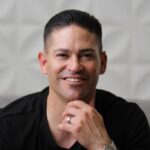 Jerome Maldonado is a highly successful real estate investor, business owner, coach and speaker. Inspired by his parents’ dedicated work-ethic, Jerome has always had a hunger for success and a willingness to do whatever it took to make his vision for his life a reality.
Jerome Maldonado is a highly successful real estate investor, business owner, coach and speaker. Inspired by his parents’ dedicated work-ethic, Jerome has always had a hunger for success and a willingness to do whatever it took to make his vision for his life a reality.
Starting from scratch, he struggled for many years to get his business off the ground, but from this he learned what it really takes to build an empire from the ground up. After years of honing his skills in sales, team building, and real estate concepts, Jerome finally built his first 6 figure business in his 20s.
In 1998, Jerome pioneered a new construction company which he took to seven figures, in less than one year. With much success came the need for expansion. Understanding the simple concepts and benefits of leasing real estate, he purchased a multi-use retail and commercial property to house his business.
Jerome found the traction and confidence which has allowed him to do millions upon millions of dollars in residential and commercial real estate transactions and holdings.
Love the show? Subscribe, rate, review, and share!
Join the Real Estate Investor Summit Community:




